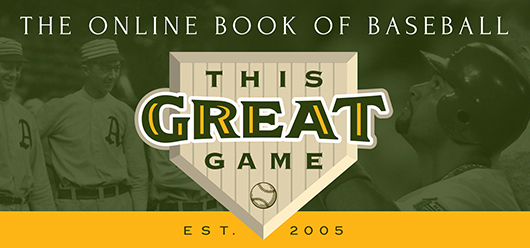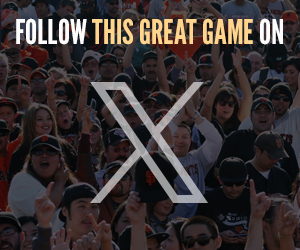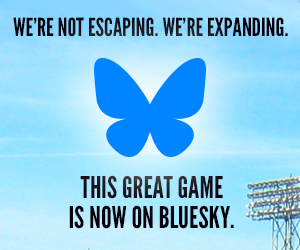THE TEAMS
The Cubs’ 10 Greatest Hitters
 Billy Williams (1959-74)
Billy Williams (1959-74)
Because of his quiet nature and his team’s repeated failure to make a dent in the pennant race during his time, Williams is often lost in the discussion of the game’s great hitters of the period, even as he continued to be so good and consistent for so long in Chicago. Although an Alabama native, Williams claimed he saw no signs of blatant racism until he began playing in the minors—and it shook him to the point that he briefly quit, only to be lobbied back by former Negro Leaguer and Cubs scout Buck O’Neil.
In his first full year on the Chicago roster in 1961, Williams earned National League Rookie of the Year honors by hitting .278 with 25 home runs and 86 RBIs; he steadily continued to produce A-list numbers for the next dozen years in Chicago, peaking in the early 1970s when he turned out two sensational seasons—hitting .322 with 42 homers and 129 RBIs in 1970, and a NL-best .333 figure with 37 blasts and 122 RBIs in 1972—but finished second in the NL MVP voting both times, losing out on each occasion to Cincinnati catcher Johnny Bench.
Williams earned the nickname Iron Man for starting in 1,117 games from 1962-71, eclipsing the NL record held by Stan Musial; Steve Garvey would tip that mark a decade later. Amazingly, Williams was voted on only 23% of ballots in his first year of Hall of Fame eligibility in 1982; it would take him six years to be given his just due and earn enshrinement into Cooperstown.
 Ryne Sandberg (1982-94, 1996-97)
Ryne Sandberg (1982-94, 1996-97)
Like Williams, Sandberg was a quiet leader immensely popular with the Wrigley Field faithful; better yet, his emergence coincided with the Cubs’ first postseason appearance in 39 years when his breakout, MVP performance of 1984 brought the team to the brink of a World Series appearance. Until then, Sandberg looked to be nothing more than another small, light-hitting but defensively sharp infielder, chucked away by Philadelphia in 1982 in a deal for Ivan DeJesus that, in hindsight, became highly ill-advised from the Phillies’ point of view.
Sandberg ramped his power up in later years, setting a career high with 30 home runs in 1989 and then resetting the mark a year later when he led the NL with 40. There was no variance in his slick defensive play; he won nine Gold Gloves at second base for the Cubs, and once played 123 straight games at second base without making an error (a record for that position later broken by Placido Polanco).
After a slow start in 1994, Sandberg—claiming he had lost the desire to play—suddenly quit, turning his back on $16 million still due to him. He returned in 1996, where he played two more years with substandard play before hanging it up for good.
 Hack Wilson (1926-31)
Hack Wilson (1926-31)
At 5’6”, 195 pounds and wearing an 18” collar and size 6 shoes, Wilson possessed one of the strangest—and most powerful—physiques in baseball history. His incredible upper-body strength helped him lead the NL in home runs four times between 1926-30, a period in which he averaged 35 homers and 142 RBIs per season.
Originally a New York Giant, Wilson became the property of the Cubs when a “clerical error” in the Giants’ front office allowed him to become a free agent (some believe the error was a cover story for manager John McGraw’s fervent desire to get rid of Wilson and his off-field antics). Wilson felt right at home in Chicago during prohibition times, as famously recalled in local sportswriter Warren Brown’s assessment of Wilson as a “highball hitter on the field—and off it.” Legend has it that Wilson once got caught in a window frame attempting to flee a speakeasy raided by police.
Wilson’s tremendous run with the Cubs hit a thunderous peak in 1930 with one of the greatest seasons by any hitter, period: He hit .356 with 56 homers—a mark that would remain the most by a National Leaguer until the Mark McGwire-Sammy Sosa duel of 1998—and he collected a mesmerizing 191 RBIs that still hold as the highest by any major leaguer. A year later, Wilson’s career imploded; his numbers dropped dramatically as the Cubs, worried that his knack for imbibing was finally catching up to him, dealt him away to Brooklyn. Wilson never regained the prodigious stroke and would be out of baseball by age 34; he died penniless just 14 years later, likely a result of his continuing battle with the bottle.
 Frank Chance (1898-1912)
Frank Chance (1898-1912)
The rugged, no-nonsense first baseman-manager was built for the times and nearly died as a result of it, his fabulous playing career cut short at the age of 31 because of a disproportionate amount of beanings (in an era without batting helmets) that led to a blood clot in his brain and permanent loss of hearing in his left ear.
Originally brought up as a catcher, Chance reluctantly moved to first base at the urging of Cubs manager Frank Selee; at his new post, Chance soon became immortalized in Franklin Adams’ poem Baseball’s Sad Lexicon in which he was evoked as part of the Chicago double-play combination along with Joe Tinker and Johnny Evers as a depressive point-of-view from a fan of the archrival New York Giants.
During his prime, Chance was a constant .300 hitter who twice led the NL in steals—leading the NL in anything offensive during the 1900s was exceptionally difficult unless your name was Honus Wagner—and was gifted at forging his way to base any way he could, whether it be by base hit, walk or by getting beaned. When Selee bowed out of managing for health reasons, he gave the job to Chance, who proceeded to win four pennants and two World Series in a five-year period as the Cubs won an unmatched yearly average of 106 games. For this he was nicknamed the Peerless Leader, a moniker hardly lost on Cubs fans who waited over a century for the team’s first world title since Chance snagged the last one in 1908.
Chance bailed out of Chicago following the 1912 season when he grew tired of the penurious meddling of Cubs boss Charles Murphy, one of baseball’s most vilified owners.
 Ernie Banks (1953-71)
Ernie Banks (1953-71)
Forever known as “Mr. Cub,” Banks may be the single most popular man to put on a Cubs uniform, thanks to his cheery disposition, his absolute love of the game (trademarked with his famous adage of “Let’s play two”) and his destructive power on opponents to the tune of 512 home runs among a club record 1,009 extra-base hits.
Banks became the first African-American to play for the Cubs after they agreed to the request of his Negro League club (the Kansas City Monarchs) that he could bypass the minors and go straight to the majors. It became readily apparent that the Monarchs knew what they were talking about, as Banks quickly emerged as a major star, hitting 44 home runs with 117 RBIs in his second full season. At his peak in the late 1950s, he homered over 40 times in four consecutive seasons and, in 1958-59, not only became the first player to win back-to-back NL MVPs, but became the first player to win the honor for a losing team (the Cubs finished below .500 both seasons). Banks’ productivity faded in the 1960s, but he was still a solid everyday fixture that helped Cubs fans tolerate the many losing campaigns during his time.
Sammy Sosa (1992-2004)
At the age of 23 in 1992, a skinny Sosa came across town in a trade from the White Sox as a raw, promising yet still unrefined talent; for the rest of the 1990s, he would embark on an amazing transformation from a speedy outfielder with burgeoning power to that of a broad-shouldered slugger who engaged in a historic chase with Mark McGwire to topple Roger Maris’ all-time season home run record. Though he would lose out to McGwire in that quest, Sosa would continue to rack up home runs the way common players collected singles; in a remarkable five-year period between 1998-2002, Sosa would belt 292 balls over the fence, the most by any player in such time.
In a stunning fact clearly indicative of the times, Sosa became the only player to hit 60 homers three times—and amazingly never led the NL in either of those years. He otherwise did pace the league twice, with 50 in 2000 and 49 in 2002. In terms of RBIs, Sosa’s 160 in 2001 and 158 in 1998 are the two highest totals by a National Leaguer since Wilson brought home his record 191 in 1930. But Sosa’s emphasis on power sapped him of his ability (or inclination) to use his once fleet feet, as noted by sportswriter Howard Bryant—who pointed out that Sosa went from being a 30-30 threat (recording 30+ homers and 30+ steals in 1993 and 1995) to that of 60-0, failing to swipe a single bag in 2001.
Sosa’s final years were marked by controversy and the inevitable decline in numbers. He was caught using a corked bat in 2003, and later was ratted out as one of the 103 players who tested positive for steroids that same year—though the latter revelation was hardly a surprise to those who saw Sosa grow from skinny speedster to bulky slugger. (Sosa himself has dodged the question of whether he took illegal performance enhancement, saying he would only answer the question once inducted into the Hall of Fame—should that moment ever occur.) He became extremely disliked by teammates for his self-absorbed presence in the clubhouse; that was something all too clearly revealed when, after Sosa bailed on the Cubs before the final game of the 2004 campaign, pitchers Kerry Wood and Mark Prior took a bat and bashed away at the boombox he constantly played aloud to the chagrin of others. Sosa was traded to Baltimore where his career sank even faster; after skipping a year, he played a final season for Texas in 2007 (where he began his career in 1989) and hit his 600th career homer amid a mild comeback performance.
 Bill Nicholson (1939-48)
Bill Nicholson (1939-48)
Nicholson is regarded as a wartime hero for the Cubs, becoming the first player in NL history to lead the league in home runs and RBIs in consecutive seasons from 1943-44 as the majors’ level of play declined during World War II. For those who think Nicholson was a common player whose numbers became inflated at the expense of inferior replacement players, it serves to note that he was an All-Star for the Cubs in 1940-41 while major league rosters were at full strength.
Nicknamed Swish but lovingly referred to as Big Bill at Wrigley Field, Nicholson peaked in 1944 when he came within a point of winning the NL MVP and, in July, became one of only a handful of players ever to be walked intentionally with the bases loaded after hitting four homers earlier in the day during a doubleheader. Nicholson’s performance slid in 1945 due to numerous health issues—among them diabetes, which would grow worse in later years. Still, he led the Cubs eight straight years in homers—including in 1946, when he belted just eight in part-time work.
Ron Santo (1960-73)
The popular, outspoken Cub was considered a supporting star during his career as Billy Williams exhibited more statistical clout and Ernie Banks more fame, but one look at his career numbers and it became hard to argue against his inclusion into the Hall of Fame—which became a topic of great debate among baseball experts.
Santo consistently put up home run totals in the 25-35 range, annually knocked in around 100 RBIs, hit for a solid average and supplemented his power by leading the NL in walks four times; he was also one of the best third basemen of his era, winning five consecutive Gold Gloves at his position. Given all of this, it’s no wonder Santo was named to nine All-Star Games. In 1974, Santo became the first player to reject a trade (to the California Angels) using the 10-and-5 clause—a privilege given to those having played 10 years in the majors and five for one team as recently bargained by the players’ union; he accepted another trade to the crosstown White Sox that allowed him to stay in Chicago.
In retirement, Santo returned to the Cubs as a radio color commentator, wearing his emotions on his sleeve as he lived and died with the Cubs on the air through his audible cheering and groaning. Like Nicholson, diabetes curtailed Santo’s later years, and the disease ultimately claimed both of his legs and contributed to his death in 2010—a year before he was finally elected into Cooperstown by the Veterans’ Committee.
 Phil Cavarretta (1934-53)
Phil Cavarretta (1934-53)
Joining the Cubs at the age of 18 in 1935, Cavarretta was a sporadic contributor to the Cubs over a 20-year tenure but was awfully good when allowed to give his all on a full-time basis, leading to popularity with several generations of Cubs fans.
Cavarretta was at his best in the 1940s, leading the NL in 1944 with 197 hits and being named the league’s MVP a year later when he batted a major league-best .355. Unlike most major league veterans, Cavarretta played right through World War II as a hearing problem made him ineligible for military service, so while that enhanced his numbers against inferior competition in 1943-45, he did prove that he could play with the big boys upon their return from the war, hitting around .300 over the next few years playing every day. Cavarretta served his final three years with the Cubs as a player-manager, leading the Cubs in 1952 to the last non-losing campaign (77-77) they would see for 11 years. He died in late 2010, just a few weeks after Santo’s passing.
 Heinie Zimmerman (1907-16)
Heinie Zimmerman (1907-16)
A great natural talent who many believed never came to full fruition, Zimmerman nevertheless emerged as one of the NL’s top hitters during the 1910s, hitting his peak in 1912 for the Cubs when he nearly won the triple crown of hitting—leading the league in home runs (14) and batting average (.372) but falling short of the RBI crown by just three. Zimmerman was aggressive at the plate, swinging with success at many a pitch outside the strike zone, but unfortunately his recklessness carried over not just to defense—often leading third basemen in errors—but off the field as well, clashing with management over salary, then spending his wages too quickly and without thought. It therefore came as no surprise when news hit in 1919 that Zimmerman, a member of the Giants three years removed from the Cubs, was suspended along with teammate Hal Chase for bribing fellow Giants pitchers to lose.
Chicago Cubs Team History A decade-by-decade history of the Cubs, the ballparks they’ve played in, and the four people who are on the franchise’s Mount Rushmore.
The Cubs’ 10 Greatest Pitchers A list of the 10 greatest pitchers based on their productivity and efficiency.
The Cubs’ 10 Most Memorable Games A list of 10 memorable games and other notable personal achievements that have defined the Cubs’ history.






